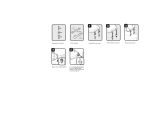
Foreword
This manual is designed primarily for use by
trained m echanics in a properly equipped shop.
However, it contains enough detail and basic in-
formation to make it useful to the owner who de-
sires to perform his own basic maintenance and
repair work. A basic knowledge of mechanics,
the proper use of tools, and workshop proce-
dures must be understood in order to carry out
maintenance and repair satisfactorily. When-
ever the owner has insufficient experience or
doubts as to his ability to do the work, all ad-
justments, m aintenance, and repair should be
carried out only by qualified mechanics.
In order to perform the work efficiently and
to avoid costly mistakes, read the text, thor-
oughly familiarize yourself with the procedures
before starting work, and then do the work care-
fully in a clean area. Whenever special tools or
equipment are specified, do not use makeshift
tools or equipment. Precision measurements
can only be m ade if the proper instruments are
used, and the use of substitute tools may ad-
versely affect safe operation.
To get the longest life out of your engine:
•
Follow the Periodic Maintenance Chart in the
Service Manual.
•
Be alert for problems and non-scheduled
maintenance.
•
Use proper tools and genuine Kawasaki en-
gine parts. Genuine parts provided as spare
parts are listed in the Parts Catalog.
•
Follow the procedures in this m anual care-
fully. Don’t take shortcuts.
•
Remember to keep complete records of main-
tenance and repair with dates and any new
parts installed.
How to Use This Manual
In preparing this manual, we divided the prod-
uct into i ts major systems. These systems be-
came the manual’s chapters. All information
for a particular system from adjustment through
disassembly and inspection is located in a sin-
gle chapter.
The Quick Reference Guide shows you all
of the product’s system and assists in locating
their chapters. Each chapter in turn has its own
comprehensive Table of Contents.
The Periodic M aintenance Chart is located
in the General Information chapter. The chart
gives a time schedule for required maintenance
operations.
If you want spark plug information, for exam-
ple, go to the Periodic Maintenance Chart first.
The chart t ells you how frequently to clean and
gap the plug. Next, use the Quick Reference
Guide t o locate the Electrical System chapter.
Then, use the Table of Contents on the first
page of the chapter to find the Spark Plug sec-
tion.
Whenever you see these WARNING and
CAUTION symbols, heed their instructions!
Always follow safe operating and maintenance
practices.
WARNING
This warning symbol identifies special
instructions or procedures which, if not
correctly followed, could r esult in per-
sonal injury, or loss of life.
CAUTION
This caution symbol identifies special
instructions or procedures which, if not
strictly observed, could result in dam-
age to or destruction of equipment.
This manual contains four more symbols (in
addition to WARNING and CAUTION) which will
help you distinguish different types of informa-
tion.
NOTE
○
This note symbol indicates points of par-
ticular interest for more efficient and con-
venient operation.
•
Indicates a procedural step or work to be
done.
○
Indicates a procedural sub-step or how to do
the work of the procedural step it follows. It
also precedes the text of a WARNING, CAU -
TION, or NOTE.
Indicates a conditional step or what action to
take based on the results of the test or inspec-
tion in the procedural step or sub-step it fol-
lows.
In m ost chapters an exploded view illustration
of the system components follows the Table of
Contents. In these illustrations you will find the
instructions indicating which parts require spec-
ified tightening torque, oil, grease or a locking
agent during assembly.





















